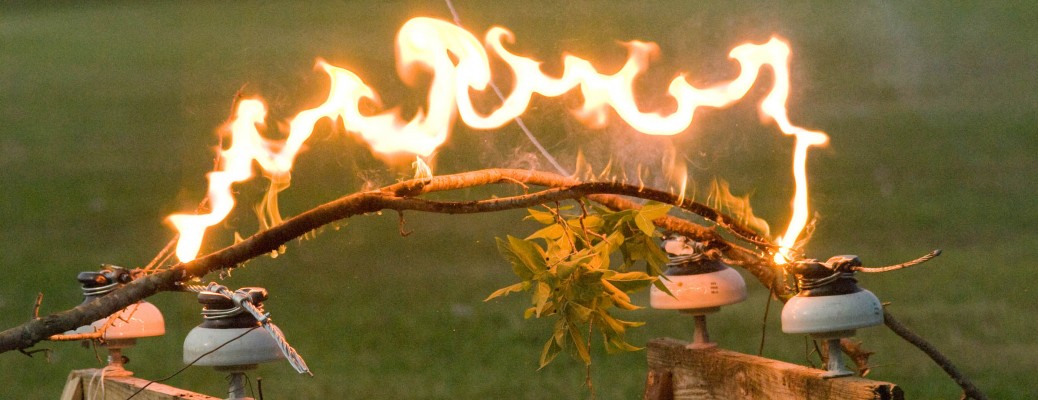Power lines have caused more than 4,000 wildfires in Texas in the past three and a half years. Power lines can ignite wildfires through a variety of mechanisms.
Downed lines– Just like homes and office buildings, power distribution systems contain protective devices (e.g. fuses, circuit breakers) that detect short-circuit fault conditions and operate to limit damage to the system. These devices are intended to clear faults quickly, but in as many as 30% of cases in which a single energized line conductor breaks and falls to earth, surface contact resistance causes the resulting fault to draw too little electrical current to blow a fuse or trip a circuit breaker. Such a condition is known as a high-impedance fault, sometimes abbreviated as a HiZ (pronounced “high zee”) fault. A line with a HiZ fault can remain energized on or near the earth for an arbitrarily long period of time, often multiple tens of minutes, during which it produces high-energy, high-temperature arcing. The image below shows a downed-conductor, HiZ arcing fault on a 7,200-volt power line. It is common for a downed line conductor to remain energized and arcing until a customer calls the utility company to report a lights-out condition, which may occur only after several tens of minutes. An arcing downed conductor readily ignites proximate vegetation and other materials, particularly if it occurs in an area of elevated fire risk. Even if conventional protection finally operates, the period of arcing already may have started a fire.
 Vegetation Contact – Trees and other vegetation intruding into power lines can cause fires in multiple ways. A tree falling across a line can tear the line down and result in a downed line. A branch spanning two line conductors for a sufficient period of time may ignite the branch and also may produce high-energy, high-temperature Jacob’s Ladder arcs multiple feet in length. If the branch remains in contact and arcing, it can cause progressive damage that eventually breaks the line. The picture below shows a tree branch that contacted a line intermittently, over a 24-hour period, and eventually burned the line down.
Vegetation Contact – Trees and other vegetation intruding into power lines can cause fires in multiple ways. A tree falling across a line can tear the line down and result in a downed line. A branch spanning two line conductors for a sufficient period of time may ignite the branch and also may produce high-energy, high-temperature Jacob’s Ladder arcs multiple feet in length. If the branch remains in contact and arcing, it can cause progressive damage that eventually breaks the line. The picture below shows a tree branch that contacted a line intermittently, over a 24-hour period, and eventually burned the line down.
Conductor Slap – Power lines are designed with sufficient clearance between conductors to keep them from contacting each other under most operating conditions. Certain unusual circumstances, however, can cause line conductors to slap together. Conductor slap creates high-energy arcing and ejects hot metal particles capable of igniting ground-level combustibles. In addition, where line conductors are made of aluminum, the ejected particles may burn as they fall.
In conjunction with line monitoring efforts at multiple utility companies, TEES has documented multiple instances of a phenomenon known as fault-induced conductor slap (FICS). FICS occurs when a fault at one location on a circuit creates sufficient magnetic forces to cause line conductors at another location, perhaps a mile or more away, to swing together and cause a second, near-simultaneous fault. Conventional tools and processes available to utility companies often do not enable correct diagnosis of this phenomenon. By contrast, TEES technology detects and reports FICS, enabling corrective action. Correct diagnosis is important because field research shows that a line span that experiences one episode of FICS likely will experience additional episodes in the future, unless the condition is identified and corrected. Detecting an episode of FICS, perhaps during a period of modest fire risk, enables corrective action that eliminates subsequent episodes, which otherwise might have occurred at times of high risk.
Repetitive Faults – Each power line fault creates some risk of fire. Most faults are isolated events (e.g. animal contact, etc.) that do not repeat. Some faults, however, will occur multiple times unless a utility takes corrective action. Repetitive faults can be caused by vegetation, conductor slap, or equipment that is in the process of failing, such as a cracked insulator. TEES intelligent monitoring detects repetitive faults and notifies utilities, providing them with information to aid in locating the underlying problem.
Apparatus Failures – Many power line components (e.g., switches, insulators, transformers, …) provide trouble-free service for decades. A typical circuit may have hundreds or even thousands of components, making it impractical to inspect or test all components on a frequent basis. Components eventually fail. As they do, they often go through an pre-failure period, during which they continue to serve load until progressive deterioration causes complete failure. Pre-failures often involve arcing and sparking at levels too small to be detected by conventional technologies. Over time the arcing and sparking may increase in intensity and, under the right conditions, can ignite proximate combustibles. More commonly these pre-failures cause progressive damage that eventually evolves into high-energy arcing or even burns conductors in two, resulting an energized wire on the ground, which provides a ready source of ignition, as discussed above.

